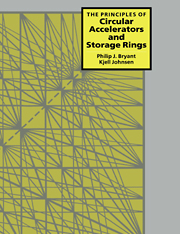Book contents
- Frontmatter
- Contents
- Foreword
- Coordinate system
- Symbols
- Useful Constants
- 1 Introduction
- 2 Basic concepts and constant-gradient focusing
- 3 Alternating-gradient focusing
- 4 Parameterisation of the transverse motion
- 5 Imperfections and resonances
- 6 Chromaticity
- 7 Longitudinal beam dynamics
- 8 Image and space-charge forces (transverse)
- 9 Coherent instabilities
- 10 Radiating particles
- 11 Diagnosis and compensation
- 12 Special aspects of circular colliders
- Appendix A Transverse particle motion in an accelerator
- Appendix B Accelerator magnets
- Appendix C Closed orbits
- Appendix D Phase equation
- Appendix E Vlasov equation
- References
- Index
8 - Image and space-charge forces (transverse)
Published online by Cambridge University Press: 11 November 2009
- Frontmatter
- Contents
- Foreword
- Coordinate system
- Symbols
- Useful Constants
- 1 Introduction
- 2 Basic concepts and constant-gradient focusing
- 3 Alternating-gradient focusing
- 4 Parameterisation of the transverse motion
- 5 Imperfections and resonances
- 6 Chromaticity
- 7 Longitudinal beam dynamics
- 8 Image and space-charge forces (transverse)
- 9 Coherent instabilities
- 10 Radiating particles
- 11 Diagnosis and compensation
- 12 Special aspects of circular colliders
- Appendix A Transverse particle motion in an accelerator
- Appendix B Accelerator magnets
- Appendix C Closed orbits
- Appendix D Phase equation
- Appendix E Vlasov equation
- References
- Index
Summary
By the early forties, machine designers understood weak focusing and phase focusing well enough for their attention to be drawn away from single-particle phenomena towards the next limitation on performance, that of space charge. For example, Kerst in 1941 was already discussing the self, or direct, space-charge force inside the beam, which was limiting the injection current and changing the optimum injection voltage into his betatron. Some years later the effects of image space-charge forces arising from the proximity of the conducting vacuum chamber walls were discussed by the MURA staff in 1959. A comprehensive theory of these two mechanisms was published by Laslett in 1963. Subsequent work has taken into account the penetration of a.c. fields through the vacuum chamber walls, the solution of image coefficients for more complicated boundary conditions, and some practical applications. These ideas have led on naturally to the new fields of study of coherent instabilities and space-charge dominated beams.
THEORETICAL CONTEXT
The overall scheme for investigating space-charge effects is summarised in Table 8.1. This chapter will concentrate on how the local self and image fields manifest themselves as an incoherent tune shift for the motion of individual particles and as a coherent tune shift for the beam as a whole.
Since the effects of interest are integrated over complete turns in the machine, it is reasonable to build the theory on the smooth or weak approximation for the single-particle unperturbed betatron motion.
- Type
- Chapter
- Information
- The Principles of Circular Accelerators and Storage Rings , pp. 170 - 187Publisher: Cambridge University PressPrint publication year: 1993



